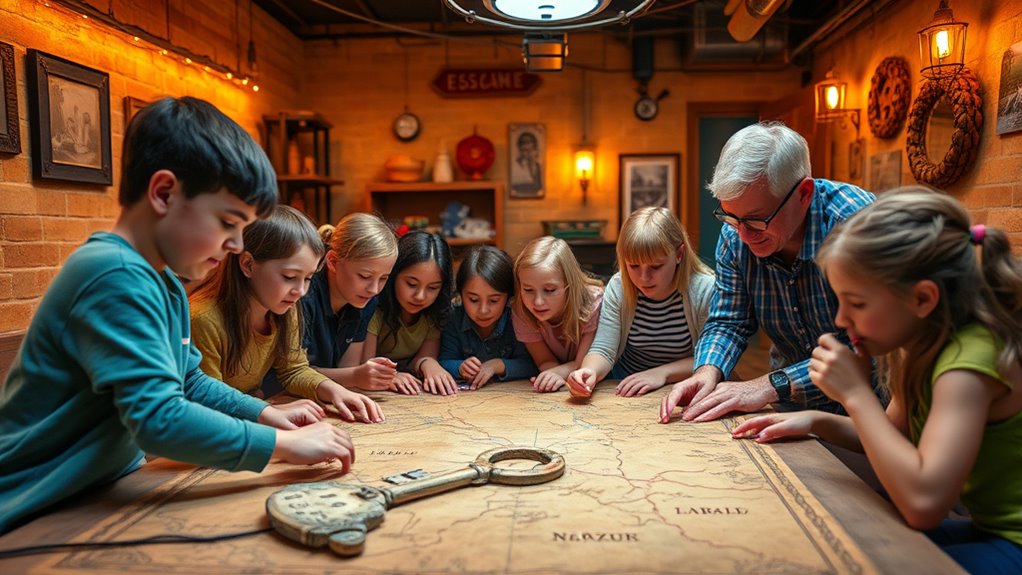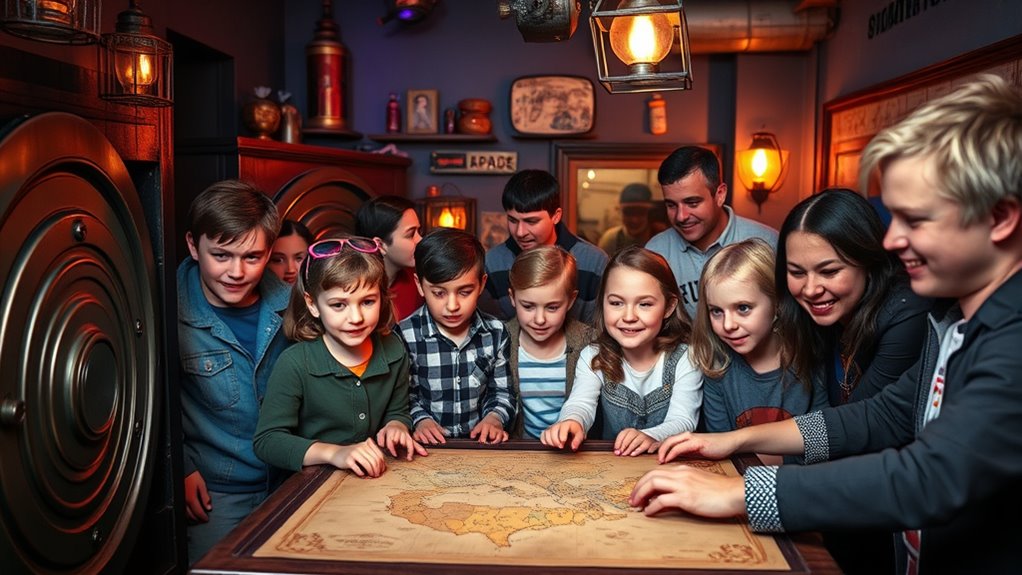When designing escape rooms for diverse audiences and age groups, focus on creating inclusive themes and puzzles that appeal to different interests and abilities. Use a mix of visual, tactile, and auditory clues to accommodate various needs, and incorporate adjustable elements like furniture or puzzle difficulty. Balance excitement with accessibility to guarantee everyone can participate fully and feel successful. Keep exploring ways to make your escape room engaging for all—more tips await you.
Key Takeaways
- Incorporate themed puzzles tailored to different age groups and cultural backgrounds to enhance engagement.
- Design puzzles with varying difficulty levels to accommodate diverse cognitive abilities and experience.
- Include accessible features such as audio cues, tactile elements, and adjustable furniture for inclusive participation.
- Use multi-sensory clues and visual descriptions to ensure accessibility for players with sensory impairments.
- Foster teamwork by creating puzzles that encourage collaboration across different ages and skill levels.

Have you ever wondered how escape room designers tailor experiences to suit different audiences? It’s a fascinating process that involves understanding the unique needs, interests, and abilities of each group. When creating an escape room for a diverse crowd, designers carefully choose themed puzzles that resonate with the participants’ backgrounds and preferences. For example, a room aimed at history enthusiasts might feature riddles based on ancient artifacts or famous events, while a sci-fi theme could include futuristic technology puzzles. These themed puzzles aren’t just about making the game more engaging; they help immerse players in the story, making the experience memorable and meaningful.
Designers also pay close attention to incorporating accessibility features into escape rooms to ensure everyone can participate. Accessibility isn’t just about adding ramps or wider doorways; it involves thoughtful modifications that accommodate players with a range of physical, sensory, or cognitive challenges. For instance, visual impairments can be addressed by providing audio clues or tactile puzzles, while those with mobility issues might benefit from adjustable furniture or clear, obstacle-free pathways. Incorporating such features not only broadens the audience but also demonstrates an inclusive approach that values every participant’s enjoyment and sense of achievement.
Incorporating thoughtful accessibility features ensures everyone can enjoy and succeed in escape room adventures.
Balancing themed puzzles with accessibility features requires a careful touch. You want to maintain the excitement and challenge of the game while making sure no one feels excluded. This might mean designing puzzles that can be solved through multiple senses or offering alternative clues for players who might struggle with traditional formats. For example, a puzzle that involves matching symbols could be supplemented with a description or an audio cue for players with visual impairments. When you integrate these elements seamlessly, the escape room becomes a space where teamwork and problem-solving thrive, regardless of individual limitations.
Ultimately, designing escape rooms for diverse audiences means thinking beyond the standard setup. It involves a conscious effort to create an inclusive environment where themed puzzles engage different interests, and accessibility features ensure everyone can participate fully. By doing so, you not only make the experience more enjoyable for a wider range of people but also foster a sense of community and achievement. When you consider these factors from the start, you craft an escape room that’s not just fun but truly welcoming for all ages and abilities.
Frequently Asked Questions
How Can Escape Rooms Accommodate Participants With Physical Disabilities?
You can accommodate participants with physical disabilities by incorporating adaptive technology and ensuring wheelchair accessibility. Make sure the escape room has ramps and wide doorways for easy movement. Use adaptive tools like touchscreens or voice-activated devices to assist those with limited mobility. By designing inclusive pathways and accessible puzzles, you create a welcoming environment where everyone can enjoy the challenge and fun of your escape room.
What Are Best Practices for Multilingual Escape Room Experiences?
Oh, you’re aiming for a multilingual escape room? Just slap on some language accessibility tools and hope everyone’s fluent in “fun.” Honestly, cultural translation is key—use clear visuals, multilingual instructions, and culturally sensitive puzzles. Avoid idioms or references that only one group gets. Test with diverse teams, tweak, and guarantee everyone’s on the same page—literally—to keep the adventure inclusive and engaging for all language backgrounds.
How Do Cultural Differences Influence Escape Room Design?
Cultural differences profoundly influence escape room design by shaping cultural symbolism and requiring design localization. You should incorporate symbols that resonate with your audience’s cultural background to enhance immersion and understanding. Be mindful of cultural sensitivities and adapt puzzles or themes accordingly. By localizing your design, you create a more engaging, respectful, and memorable experience that appeals to diverse cultural perspectives and avoids misunderstandings.
What Safety Considerations Are Essential for Children’s Escape Rooms?
You should prioritize child-proofing hazards by securing sharp objects, small parts, and unstable furniture to prevent injuries. Confirm emergency exits are clearly marked, easily accessible, and unobstructed for quick evacuation. Use soft, non-toxic materials and install safety barriers where needed. Regularly inspect the room for potential risks, and provide adult supervision to keep children safe throughout the escape experience. These measures create a secure environment for young participants.
How Can Escape Rooms Be Adapted for Neurodiverse Participants?
Think of adapting escape rooms for neurodiverse participants as tuning a musical instrument. You can do this by providing sensory accommodations, like noise-canceling headphones or soft lighting, and offering cognitive supports such as clear instructions, visual aids, or breaks. These adjustments help create an inclusive environment where everyone feels comfortable and engaged, ensuring that each player can enjoy the challenge without feeling overwhelmed or misunderstood.
Conclusion
Designing escape rooms for diverse audiences means creating experiences everyone can enjoy. Did you know that 85% of players say their favorite part is the teamwork and shared achievement? By tailoring puzzles and themes to different age groups and backgrounds, you make the adventure inclusive and memorable. When you consider these factors, you’re not just designing a game—you’re building connections and unforgettable moments for every participant. That’s the true success of a great escape room.









